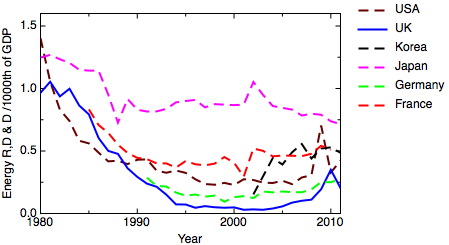Seven years after a change in UK energy policy called for a new generation of nuclear power stations to be built, today’s announcement of a deal with the French energy company EDF to build two nuclear power plants at Hinckley point marks a long overdue step forward. But the deal is a spectacularly bad one for the UK. It locks us into high energy prices for a generation, it yields an unacceptable degree of control over a strategic asset to a foreign government, it risks sacrificing the opportunity nuclear new build might have given us to rebuild our industrial base, and it will cost us tens of billions of pounds more than necessary. It’s all to preserve political appearances, to allow the government to appear to be abiding by its unwisely made commitments.
The UK is committed to privatised energy markets, no subsidies for nuclear power, and is unwilling to issue new government debt to pay for infrastructure. An opposition to state involvement in energy seems to apply only to the UK state, though, as this deal demonstrates. EDF is majority owned by the French Government, while the Chinese nuclear companies China General Nuclear and China National Nuclear Corporation, who will be co-investing in the project, are wholly owned and controlled by the Chinese government. The price of this investment (as reported by the FT’s Nick Butler) is some as yet unspecified degree of operational involvement. It seems extraordinary that the government is prepared to allow such a degree of involvement in a strategic asset by the agents of a foreign state.
The deal will not, it’s true, be directly subsidised by the UK government (except, and not insignificantly, for an implicit subsidy in the form of a disaster insurance guarantee). Instead future electricity consumers will pay the subsidy, in the form of a price guarantee set at around twice the current wholesale price of electricity, to rise with inflation over 35 years.
The quoted price for two European Pressurised Water Reactors of 1.6 GWe capacity is £16 billion. The first of this reactor design to be built, at Olkiluoto in Finland, started out with a price of €3 billion, but after delays and overruns the current estimate is €8.5 billion. So the quoted price for two of £16 billion – €9.45 billion – bakes in this cost overrun and adds a little bit more for luck. How much of this £16 billion will come back to the UK in the form of jobs and work for UK industry? It is difficult to say, because no commitments seem to have been made that a certain fraction of work should come to the UK. Given the fact that the UK government isn’t paying for the reactors, it doesn’t have a lot of leverage on this.
How bad a deal is this in monetary terms? The strike price is £92.50 per MWh, falling to £89.50 if EDF goes ahead with another pair of reactors at Sizewell, fully inflation indexed to the consumer price index. A recent OECD report (PDF) gives some idea of costs; for reactors of this type operating in France it estimates fuel cycle costs as $9.33 per MWh, operations and maintenance at $16 per MWh, with $0.05 per MWh needed to be set aside to cover the final costs of decommissioning. Taking these together this comes to a little less than £16 per MWh. This leaves £76.50 per MWh to cover the cost of capital of the £16 billion it takes to build it. Assuming EDF manage to run their 3.2 MW of capacity at a 90% load factor, this gives them and their investors £1.9 billion a year, or a total return of £67 billion, fully protected against inflation, for their £16 billion investment.
How much would it cost if the UK government itself decided that it should invest in the plant? The UK government can currently borrow money for 30-40 years at 3.5%. The fully amortised loan for £16 billion over 35 years would cost £28 billion. Unlike the deal agreed with EDF and the Chinese, these borrowing costs would not rise with inflation. Even without accounting for inflation, the UK Government’s ideological opposition to borrowing money to pay for infrastructure carries a price tag of around £40 billion, that will have to be paid by UK industry and consumers over the next 35 years.
I do think we need a new generation of nuclear power stations in the UK, but this model for achieving that seems unsustainable. It’s time for a complete rethink. For more background on why we are where we are, see my last post, Moving beyond nuclear power’s troubled history.
Update at 8.40am 21/10: the Energy Minister, Ed Davey, said on Radio 4 this morning that there was a commitment for 57% of the value of the deal to be spent with UK firms. This isn’t mentioned in the press release.
Update 2, 22/20: The CEO of EDF was reported yesterday as saying that 57% involvement of UK firms wasn’t a commitment, but an upper limit. So I think my original comments stand.

